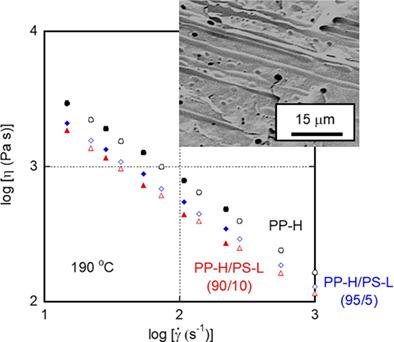当前位置:
X-MOL 学术
›
Polym. Eng. Sci.
›
论文详情
Our official English website, www.x-mol.net, welcomes your
feedback! (Note: you will need to create a separate account there.)
Viscosity decrease by interfacial slippage between immiscible polymers
Polymer Engineering and Science ( IF 3.2 ) Pub Date : 2021-01-18 , DOI: 10.1002/pen.25642 Nantina Moonprasith 1, 2 , Muhammad Shahrulnizam Nasri 1 , Riza Asmaa Saari 1 , Panitha Phulkerd 1 , Masayuki Yamaguchi 1
Polymer Engineering and Science ( IF 3.2 ) Pub Date : 2021-01-18 , DOI: 10.1002/pen.25642 Nantina Moonprasith 1, 2 , Muhammad Shahrulnizam Nasri 1 , Riza Asmaa Saari 1 , Panitha Phulkerd 1 , Masayuki Yamaguchi 1
Affiliation

|
The rheological behavior under pressure‐driven shear flow was studied using binary blends with a sea‐island structure. The addition of a low‐viscosity dispersion having a high interfacial tension with the continuous phase greatly reduces the shear viscosity, for example, the addition of atactic polystyrene (PS) with a low viscosity to isotactic polypropylene (PP) and the addition of PP with a low viscosity to PS. The interfacial slippage occurs because of the poor adhesive strength with the enlarged interfacial area and is responsible for the viscosity decrease. When the dispersion has a similar viscosity to the continuous phase, the viscosity decrease is barely detected. This is because the deformation of dispersed droplets is restricted, which creates a small interfacial area. The interfacial tension between the continuous and dispersed phases plays a crucial role on the shear viscosity. In the case of PP, the addition of linear low‐density polyethylene with a relatively low interfacial tension to PP has almost no impact on the shear viscosity. This is despite the polyethylene having a low viscosity.
中文翻译:

由于不混溶的聚合物之间的界面滑动,粘度降低
使用具有海岛结构的二元混合物研究了在压力驱动的剪切流下的流变行为。在连续相中添加具有高界面张力的低粘度分散体会大大降低剪切粘度,例如,将等低粘度的无规立构聚苯乙烯(PS)添加到等规聚丙烯(PP)中,以及将PP添加到对PS的粘度低。界面滑移的发生是由于较差的粘合强度和增大的界面面积,并且是导致粘度降低的原因。当分散体具有与连续相相似的粘度时,几乎检测不到粘度降低。这是因为限制了分散的液滴的变形,这产生了小的界面面积。连续相和分散相之间的界面张力对剪切粘度起着至关重要的作用。对于PP,在PP中添加具有相对较低界面张力的线性低密度聚乙烯几乎不会影响剪切粘度。尽管聚乙烯的粘度低。
更新日期:2021-01-18
中文翻译:

由于不混溶的聚合物之间的界面滑动,粘度降低
使用具有海岛结构的二元混合物研究了在压力驱动的剪切流下的流变行为。在连续相中添加具有高界面张力的低粘度分散体会大大降低剪切粘度,例如,将等低粘度的无规立构聚苯乙烯(PS)添加到等规聚丙烯(PP)中,以及将PP添加到对PS的粘度低。界面滑移的发生是由于较差的粘合强度和增大的界面面积,并且是导致粘度降低的原因。当分散体具有与连续相相似的粘度时,几乎检测不到粘度降低。这是因为限制了分散的液滴的变形,这产生了小的界面面积。连续相和分散相之间的界面张力对剪切粘度起着至关重要的作用。对于PP,在PP中添加具有相对较低界面张力的线性低密度聚乙烯几乎不会影响剪切粘度。尽管聚乙烯的粘度低。











































 京公网安备 11010802027423号
京公网安备 11010802027423号